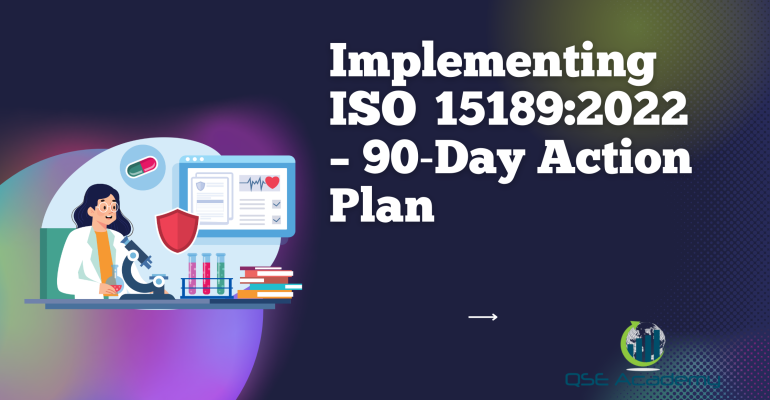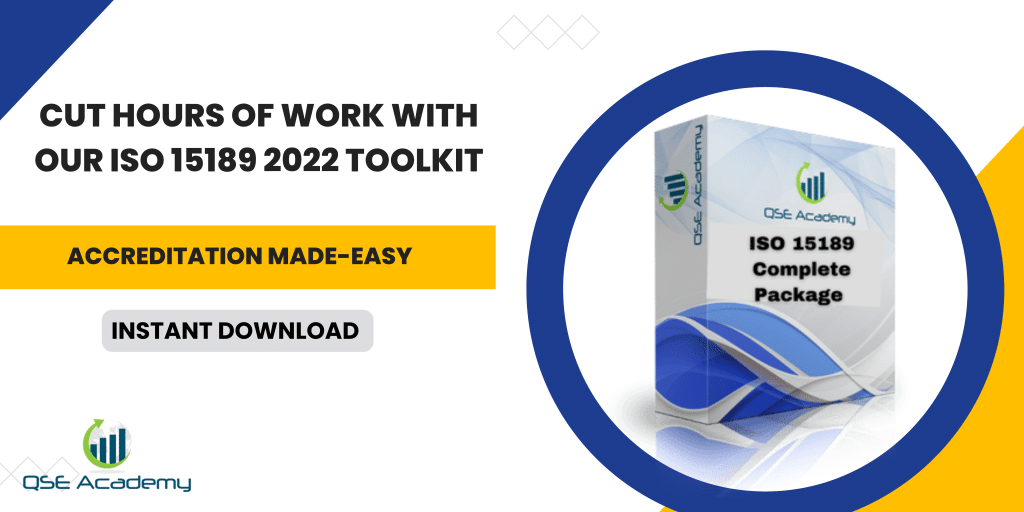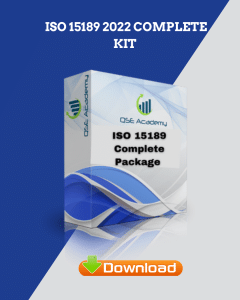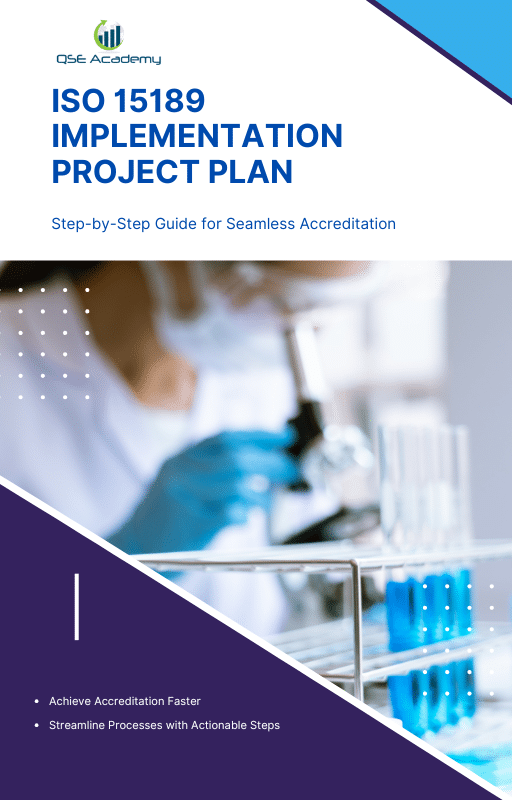Implementing ISO 15189:2022 – 90‑Day Action Plan
Last Updated on October 22, 2025 by Hafsa J.
A Clear, Practical Roadmap to ISO 15189:2022 Accreditation
Implementing ISO 15189:2022 can feel overwhelming, especially for laboratories that are already busy managing day-to-day testing, staff schedules, and client expectations. Between understanding new clauses, building documentation, and preparing for audits, it’s easy to lose track of where to begin—or how to stay on schedule.
This pillar guide lays out a 90-day action plan to help your laboratory implement ISO 15189 in a structured, achievable way. It’s designed for practical use—clear steps, realistic timelines, and a focus on what truly drives compliance.
You’ll learn how to plan your implementation from day one, build a lean Quality Management System, train your staff, conduct internal audits, and prepare for accreditation—all without wasting time or resources.
Whether your goal is full accreditation or aligning with international best practices, this 90-day framework gives you a roadmap to get there confidently and efficiently.
Now that the objective is clear, let’s break down what ISO 15189 implementation really involves—and how to turn it into a manageable project instead of a long, uncertain process.
Understanding the ISO 15189:2022 Implementation Journey
Before you dive into timelines and checklists, it’s important to understand what ISO 15189 implementation actually means. It’s not about filling binders or buying expensive tools—it’s about transforming how your laboratory operates so that quality, competence, and consistency become part of everyday work.
Implementation simply means translating the clauses of ISO 15189:2022 into your real-world processes. It’s where theory meets practice. Every clause—from management commitment and staff competence to risk management and continual improvement—needs to be reflected in how your lab functions, not just how it’s documented.
Think of the implementation journey as a series of structured phases:
-
Preparation: understanding the standard, identifying your current gaps, and defining your scope.
-
System development: building your quality management framework, documentation, and records.
-
Verification: running internal audits, management reviews, and ensuring readiness for assessment.
Each phase builds on the last, creating a logical flow from planning to accreditation.
Pro Tip: Don’t view this as a one-time project. ISO 15189 is a continuous cycle of improvement. The more naturally your lab’s routine aligns with the standard, the easier compliance becomes over time.
Now that the path is clear, let’s look at how to structure these phases into a 90-day action plan that keeps your lab organized, accountable, and on track.
The 90-Day Action Plan Overview
A 90-day implementation plan gives your laboratory focus, urgency, and structure. It’s long enough to make meaningful progress but short enough to maintain momentum. The goal isn’t to rush—it’s to break ISO 15189 implementation into manageable, sequential steps that deliver real results.
This plan follows a simple three-phase approach:
-
Days 1–30: Preparation and Gap Analysis
Understand the requirements, evaluate your current practices, and define priorities. This phase sets the foundation for everything that follows. -
Days 31–60: System Development and Implementation
Build your Quality Management System, write and adapt procedures, conduct staff training, and start implementing key operational controls. -
Days 61–90: Verification and Accreditation Readiness
Perform internal audits, hold your management review, correct any nonconformities, and finalize readiness for the accreditation assessment.
Each phase has a clear purpose, deliverables, and checkpoints. The plan can be adjusted to fit your laboratory’s size and capacity, but the sequence should remain the same. Skipping steps or rearranging priorities often leads to confusion or rework later.
Pro Tip: Assign a project leader early on—someone who can coordinate tasks, follow up on progress, and keep the team accountable. Even in small labs, having one clear point of contact keeps the plan moving smoothly.
Next, we’ll look at how to get started with the first 30 days—preparation and gap analysis, the stage that sets the tone for a successful ISO 15189 journey.
Days 1–30: Preparation and Gap Analysis
The first 30 days are all about clarity—understanding where your laboratory currently stands and what’s needed to meet ISO 15189:2022 requirements. This phase sets the foundation for everything that follows, so resist the urge to start writing procedures right away.
Start with a structured gap analysis. Review each clause of the standard and compare it to your current operations. Identify which processes already comply, which need adjustment, and which don’t exist yet. From there, create a prioritized action plan.
Key tasks for this phase include:
-
Define your scope – clarify which tests or departments fall under ISO 15189.
-
Assign responsibilities – designate a project lead and section heads for documentation, training, and audits.
-
Assess resources – review available staff, budget, and equipment calibration status.
-
Develop your project plan – outline major milestones, deliverables, and target dates.
-
Begin communication – inform your team of goals and expectations early to ensure buy-in.
Pro Tip: Keep your findings visible. A simple spreadsheet or dashboard showing each clause, its status, and responsible person keeps everyone aligned and motivated.
By the end of the first month, you should have a clear picture of your lab’s readiness, a defined implementation team, and a realistic action plan. With that clarity, you’re ready to move into the next phase—building your Quality Management System and putting the plan into motion.
Days 31–60: Building Your Quality Management System (QMS)
This is where your plan turns into action. During the next 30 days, the focus shifts from identifying gaps to actually building your Quality Management System—the core of ISO 15189 compliance.
Start by developing your key documents:
-
Quality Manual: defines your lab’s policies, scope, and structure.
-
Standard Operating Procedures (SOPs): describe how testing, calibration, reporting, and quality control are performed.
-
Forms and Records: provide evidence that your processes are followed and results are traceable.
Implement document control right away so every revision, approval, and update is tracked.
At the same time, begin staff training and competence evaluations. Make sure everyone understands their role in the QMS and how their daily tasks tie into ISO 15189 requirements.
Pro Tip: Keep your QMS lean. Avoid over-documenting; auditors value clarity and consistency more than volume. Focus on procedures that reflect how your lab actually operates.
Example: One small diagnostic laboratory reduced its documentation workload by half simply by merging related SOPs into a single, user-friendly format. This streamlined approach made training easier and improved compliance.
By the end of Day 60, your QMS should be documented, implemented in practice, and ready for testing through audits and reviews. Next comes the most critical phase—verifying that your system truly works.
Days 61–90: Internal Audit, Management Review, and Accreditation Readiness
The final 30 days are about validation—proving your system works before the accreditation body arrives. This is where everything comes together: documents, records, training, and performance data.
Start with your internal audit. Use your finalized Quality Management System as the baseline and review every clause of ISO 15189:2022 against your lab’s actual practices. The goal is to confirm that what’s written in your procedures matches what’s happening in reality. Document your findings and classify them as conformities, minor gaps, or major nonconformities.
Next, conduct your management review. This meeting should evaluate key quality metrics, internal audit results, risk findings, and staff competence. Use it to make data-driven decisions—approve improvements, assign corrective actions, and confirm your lab’s readiness for external assessment.
By this stage, you should have:
-
All mandatory documents and records in place
-
Completed staff training and competence evaluations
-
A full internal audit report with corrective actions tracked
-
Management review minutes showing leadership commitment
-
Calibration, maintenance, and verification records ready for review
Pro Tip: Treat this phase as a full rehearsal for your accreditation visit. Ask yourself, “If the assessor walked in today, could we demonstrate compliance for every clause?” If the answer is yes, you’re ready.
Once your lab passes its internal checks, you’ll transition from implementation to accreditation—confident, organized, and audit-ready.
The next section will show you how to use practical tools and templates to keep every phase of your 90-day plan structured and efficient.
Practical Tools and Templates for Each Phase
A successful 90-day implementation doesn’t rely on guesswork—it relies on structure. Using the right tools at each stage keeps your project organized, your records consistent, and your team aligned. The best part? Most of these tools can be built or adapted internally at little to no cost.
Here’s a quick reference of what to use and when:
| Phase | Tool / Template | Purpose |
|---|---|---|
| Days 1–30 | Gap-Analysis Checklist | Identify compliance gaps clause by clause. |
| Days 1–30 | Project-Plan Template | Track milestones, responsibilities, and progress. |
| Days 31–60 | Quality Manual & SOP Templates | Establish your documentation foundation. |
| Days 31–60 | Training Matrix | Track competence and refresher sessions. |
| Days 61–90 | Internal Audit Checklist | Verify system effectiveness before the assessment. |
| Days 61–90 | Management Review Form | Record decisions, actions, and leadership approval. |
These templates create consistency across your implementation process. Even a small lab can maintain professional-level documentation with simple spreadsheets or shared digital folders.
Pro Tip: Choose tools that your team can actually use. A well-structured Excel tracker that everyone updates beats a complex software no one touches.
Once your tools are in place, you’ll move more confidently through each milestone. But even the most organized plan can face obstacles—so the next step is learning to avoid common pitfalls before they slow you down.
Common Pitfalls and How to Avoid Them
Even with a solid plan, small missteps can slow down your ISO 15189 implementation. The good news is that most issues are predictable—and easy to prevent once you know what to look for.
Here are the most common pitfalls I’ve seen and how to steer clear of them:
-
Unclear project scope.
Labs often try to include every test or section at once. Start with a focused scope—just the areas ready for accreditation. You can expand later. -
Over-documenting.
More documents don’t mean better compliance. Keep procedures lean and practical. If staff can’t follow them, the system fails. -
Neglecting staff engagement.
ISO 15189 is a team effort. If only the quality officer understands the system, implementation stalls. Include everyone from day one. -
Ignoring risk management.
Clause 8.5 requires risk-based thinking. Don’t treat it as theory—create a simple risk register and update it after every internal audit or incident. -
Last-minute audit prep.
Waiting until the end to gather evidence always leads to stress. Build audit readiness into your daily routine from the start.
Pro Tip: Schedule short, biweekly check-ins with your implementation team. A 30-minute review of tasks and gaps keeps momentum steady and prevents surprises at the end of the 90 days.
Once you know what to avoid, you can focus on what really matters—keeping your system running smoothly even after accreditation.
Maintaining Momentum Beyond Day 90
Reaching Day 90 doesn’t mean the work is over—it means your laboratory is ready to transition from “implementation mode” to “continual improvement.” ISO 15189 isn’t a certificate you hang on the wall; it’s a framework that keeps your operations reliable long after the initial audit.
Here’s how to sustain progress without adding complexity:
- Schedule mini-audits. Review one or two clauses every month instead of waiting for an annual audit. It keeps compliance visible and effortless.
- Refresh training regularly. Dedicate a short session every quarter to revisit one process or quality objective.
- Track your KPIs. Keep measuring turnaround times, sample errors, and corrective actions. Small shifts in data highlight early issues before they grow.
- Update risk and improvement logs. Record even minor improvements—they count as evidence of continual improvement.
- Plan for surveillance visits early. Keep a running log of changes so you’re never scrambling to prepare for the next assessment.
Pro Tip: Build quality into your routine. If you spend ten minutes a week updating logs and records, you’ll spend zero nights rushing before your next audit.
Consistency after accreditation is what separates sustainable systems from temporary fixes. And that’s the essence of ISO 15189—continuous reliability, not one-time compliance.
Next, we’ll address a few of the most common questions labs ask when working through a 90-day implementation.
10. FAQs – Quick Answers for First-Time Implementers
Q1. Can a small or medium-sized lab really complete ISO 15189 implementation in 90 days?
Yes—if the plan is realistic and well-structured. The key is focus. The 90-day action plan works best when each week has clear goals, accountability, and progress tracking. Small labs often move faster because decision-making and documentation are simpler.
Q2. Do we need special software or paid tools to manage the implementation?
No. ISO 15189 doesn’t require any specific software. Shared folders, spreadsheets, and simple trackers are perfectly acceptable if they’re properly maintained. What matters most is control—who updates, approves, and reviews documents—not the platform you use.
Q3. What if our lab can’t meet the 90-day timeline?
That’s completely fine. The 90-day plan is a structured guide, not a rigid deadline. Extend by 30 days if needed—but maintain the sequence and discipline of milestones. Progress, documentation, and consistency always matter more than speed.
Q4. Can we start implementation before finalizing our equipment calibration and validation?
Absolutely. Begin with your QMS framework—policies, SOPs, and training. Equipment and method validation can proceed in parallel. What’s important is that every activity is documented and traceable when the audit comes.
Now that we’ve clarified those essentials, let’s close this guide with one clear message: implementation success isn’t about speed or spending—it’s about structure, clarity, and sustained effort.
From Planning to Accreditation in 90 Days
Implementing ISO 15189:2022 doesn’t have to be complicated. With a structured plan, clear priorities, and consistent follow-through, any laboratory—regardless of size or budget—can build a compliant system within 90 days.
The goal of this framework is simple: turn uncertainty into action. Each phase moves your lab closer to operational excellence—starting with gap analysis, building your QMS, empowering your team, and finishing with confident audit readiness.
In practice, the laboratories that succeed are those that stay disciplined, document as they go, and treat ISO 15189 not as a project, but as a continuous improvement habit.
If you’re ready to start your implementation, use QSE Academy’s ISO 15189:2022 90-Day Implementation Toolkit—complete with templates, checklists, and a structured planner to guide every milestone from day one.
Accreditation isn’t just about compliance—it’s about building a system that consistently delivers quality, trust, and confidence in every result your laboratory produces.
Whether it’s ISO 9001, ISO 22000, or the cosmetics-focused ISO 22716, I’ve spent my career I’m not here to call myself an expert—I prefer “enthusiast” because I truly love what I do. When I’m not writing about standards, you’ll probably find me playing Piano 🎹, connecting with people, or diving into my next big project💫. I’m an engineer specialized in the food and agricultural industry
make ISO standards less intimidating and more approachable for everyone.
turning complex jargon into clear, actionable steps that businesses can actually use.
There’s something incredibly rewarding about helping people navigate food safety and quality management systems
in a way that feels simple, practical, and even enjoyable.
I have a Master’s in QHSE management and over 12 years of experience as a Quality Manager
I’ve helped more than 15 companies implement ISO 9001, ISO 22000, ISO 22716, GMP, and other standards
My clients include food producers, cosmetics manufacturers, laboratories, and service companies
I believe quality systems should be simple, useful, and efficient.













